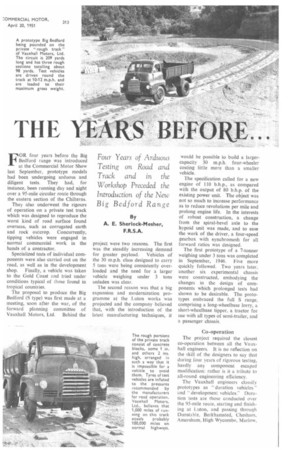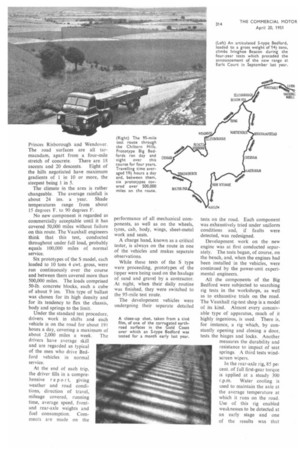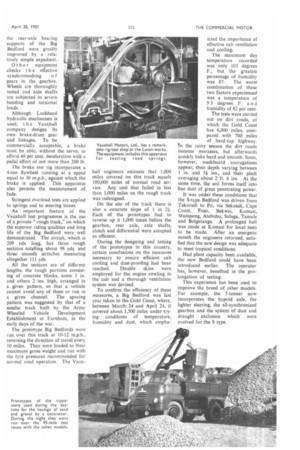THE YEARS BEFORE..
Page 93

Page 94

Page 95

If you've noticed an error in this article please click here to report it so we can fix it.
By A. E. Sherlock-Mesher, F.R.S.A.
Four Years of Arduous Testing on Road and Track and in the Workshop Preceded the Introduction of the New Big Bedford Range FOR four years before the Big Bedford range was introduced at the Commercial Motor Show last September, prototype models had been undergoing arduous and diligent tests. They had, for instance, been running day and night over a 95-mile circular route through the eastern section of the Chilterns.
They also underwent the rigours of operation on a private test track which was designed to reproduce the worst kind of road surface found overseas, such as corrugated earth and rock outcrop. Concurrently, tipping vehicles were engaged in normal commercial work in the hands of a contractor.
Specialized tests of individual components were also carried out on the road, as well as in the development shop. Finally, a vehicle was taken to the Gold Coast and tried under conditions typical of those found in tropical countries.
The proposal to produce the Big Bedford (S type) was first made at a meeting, soon after the war, of the forward planning committee of Vauxhall Motors, Ltd. Behind the project were two reasons. The first was the steadily increasing demand for greater payload. Vehicles of the 30 m.p.h. class designed to carry 5 tons were being consistently overloaded and the need for a larger vehicle weighing under 3 tons unladen was clear.
The second reason was that a big expansion and modernization programme at the Luton works was projected and the company believed that, with the introduction of the latest manufacturing techniques, it would be possible to build a largercapacity 30 m.p.h. four-wheeler costing little more than a smaller vehicle.
The specification called for a new engine of 110 h.h.p., as compared with the output of 80 b.h.p. of the existing power unit. The object was not so much to increase performance as to reduce revolutions per mile and prolong engine life. In the interests of robust construction, a change from the spiral-bevel axle to the hypoid unit was made, and to ease the work of the driver, a four-speed gearbox with synchromesh for all forward ratios was designed.
The first prototype of a 7-tonner weighing under 3 tons was completed in September, 1946. Five more quickly followed. Two years later. another six experimental chassis were constructed, embodying the changes in the design of components which prolonged tests had shown to be desirable. The prototypes embraced the full S range, comprising a long-wheelbase lorry, a short-wheelbase tipper, a tractor for use with all types of semi-trailer, and a passenger chassis.
Co-operation The project required the closest co-operation between all the Vauxhall engineers, it is no reflection on the skill of the designers to say that during four years of rigorous testing, hardly any component escaped modification: rather is it a tribute to all-round engineering efficiency.
The Vauxhall engineers classify prototypes as "duration vehicles" and development vehicles." Duration tests are those conducted over the 95-mile route, starting and finishing at Luton, and passing through Dunstable, Berkhamsted, Chesham, Amersham, High Wycombe, Marlow, Princes Risborough and Wendover. The road surfaces are all tarmacadam, apart from a four-mile stretch of concrete. There are 18 ascents and 20 descents. Eight of the hills negotiated have maximum gradients of 1 in 10 or more, the steepest being 1 in 5.
The climate in the area is rather changeable. The average rainfall is about 24 ins, a year. Shade temperatures range from about 15 degrees F. to 90 degrees F.
No new component is regarded as commercially acceptable until it has covered 50,000 miles without failure on this route. The Vauxhall engineers think that this test, conducted throughout under full load, probably equals 100,000 miles of normal service.
Six prototypes of the S model, each loaded to 10 tons 4 cwt. gross, were run continuously over the course and between them covered more than 500,000 miles. The loads comprised 50-lb. concrete blocks, each a cube of about 9 ins. This type of ballast was chosen for its high density and for its tendency to flex the chassis, body and springs to the limit.
Under the standard test procedure, drivers work in shifts and each vehicle is on the road for about 19.. hours a day, covering a maximum of about 2,000 miles a week. The drivers have average skill and are regarded as typical of the men who drive Bedford vehicles in normal service.
At the end of each trip, the driver fills in a comprehensive repor t, giving weather and road conditions, direction of travel, mileage covered, running time, average speed, frontand rear-axle weights and fuel consumption. Comments are made on the performance of all mechanical components, as well as an the wheels, tyres, cab, body, wings, sheet-metal work and seats.
A charge hand, known as a critical tester, is always on the route in one of the vehicles and makes separate observations.
While these tests of the S type were proceeding, prototypes of the tipper were being used on the haulage of sand and gravel by a contractor. At night, when their daily routine was finished, they were switched to the 95-mile test route.
The development vehicles were undergoing their separate detailed tests on the road. Each component was exhaustively tried under uniform conditions and, if faults were detected, was redesigned.
Development work on the new engine was at first conducted separately. The tests began, of course, on the bench, and, when the engines had been installed in the vehicles, were continued by the power-unit experimental engineers.
All the components of the Big Bedford were subjected to searching rig tests in the workshops, as well as to exhaustive trials on the road. The Vauxhall rig-test shop is a model of its kind. Almost every conceivable type of apparatus, much of it highly ingenious, is used. There is, for instance, a rig which, by constantly opening and closing a door, tests the hinges and locks. Another measures the durability and resistance to impact of seat springs. A third tests windscreen wipers.
In the rear-axle rig, 85 per cent, of full first-gear torque is applied at a steady 300
r.p.m. Water cooling is used to maintain the axle at the average temperature at which it runs on the road. Use of this rig enabled weaknesses to be detected at an early stage and one of the results was that the rear-axle bearing supports of the Big Bedford were greatly improved by a relatively simple expedient.
Other equipment checks t h e effective synahromeshing o f gears in the gearbox. Wheels are thoroughly tested and axle shafts are subjected to severe bending and torsional loads.
Although Lockheed hydraulic mechanism is used, I h e Vauxhall company designs its own brake-drum gear and linkages. To be commercially acceptable, a brake must be able, without the servo, to afford 40 per cent, deceleration with a pedal effort of not more than 200 lb.
The brake test rig incorporates a 4-ton flywheel running at a speed equal to 30 m.p.h., against which the brake is applied. This apparatus also permits the measurement of fade.
Stringent overload tests are applied to springs and to steering boxes.
An important feature of the Vauxhall test programme is the use of a private " rough track," on which the superior riding qualities and long life of the Big Bedford were well demonstrated. The circuit, which is 209 yds. long, has three rough sections totalling about 98 yds. and three smooth stretches measuring altogether 111 yds.
All the sections are of different lengths, the rough portions consisting of concrete blocks, some 1 in. and others 2 ins, high, arranged in a given pattern, so that a vehicle cannot avoid any of them or run in a given channel. The spacing pattern was suggested by that of a similar track built by the Army Wheeled Vehicle Development Establishment at Farnham, in the early days of the war.
The prototype Big Bedfords were run over this track at 10-12 m.p.h., reversing the direction of travel every 10 miles. They were loaded to their maximum gross weight and run with the tyre pressures recommended for normal road operation. The Vaux hall engineers estimate that 1,000 miles covered on this track equals 100,000 miles of normal road service. Any unit that failed in less than 1,000 miles on the rough track was redesigned.
On the site of the track there is also a concrete slope of 1 in 2/. Each of the prototypes had to reverse up it 1,000 times before the gearbox, rear axle, axle shafts, clutch and differential were accepted as efficient.
During the designing and testing of the prototypes in this country, certain conclusions on the measures necessary to ensure efficient cab cooling and dust-proofing had been reached. Double skins were employed for the engine cowling in the cab and a thorough ventilation system was devised.
To confirm the efficiency of these measures, a Big Bedford was last year taken to the Gold Coast, where, between March 24 and April 24, it covered about 1,500 miles under trying conditions of temperature, humidity and dust, which empha
sized the importance of effective cab ventilation and cooling.
The maximum day temperature recorded was only 103 degrees F., but the greatest percentage of humidity was 87. The worst combination of these two factors experienced was a temperature of 93 degrees F. and humidity of 82 per cent.
The tests were carried out on dirt roads, of which the Gold Coast has 6,000 miles, compared with 700 miles of hard-top highway. In the rainy season the dirt roads become morasses, but afterwards quickly bake hard and smooth. Soon, however, washboard corrugations appear, their depth varying between 1 in. and 31 ins., and their pitch averaging about 2 ft. 6 ins. At the same time, the soil forms itself into fine dust of great penetrating power.
It was under these conditions that the S-type Bedfor.d was driven from Takoradi to Po, via Sekondi, Cape Coast, Foso, Bekwai, Kumasi, Mampong, Atebubu, Salaga, Tamale and Bolgatanga. A prolonged halt was made at Kumasi for local tests to be made. After an energetic month the engineers returned, satisfied that the new design was adequate to meet tropical conditions.
Had plant capacity been available, the new Bedford could have been introduced earlier. The operator has, however, benefited in the prolongation of testing.
This experience has been used to improve the breed of other models. For example, the 5-tonner now incorporates the hypoid axle, the lighter steering, the all-synchronized gearbox and the system of dust and draught exclusion which were evolved for the S type.








































































































































































































